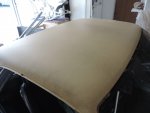skullandbones
New member
I have a fiberglass roadster that I'm doing bodywork on. So far I have covered the parting lines with filler after some fiberglass resin spot repairs. At first, I did a minimal coating of filler and primed with hot rod black primer. After registering I've been driving a lot. So I finally broke down and started doing the body work . This time I focused on getting the curves right (no flats on this cobra body). But I got to a point where I couldn't tell if I was done. So I painted the whole thing with black lacquer. I know I probably should have gone with the guide coat but I was not familiar with the use of it and was afraid of wasting my time learning. So that's where I am now. I hope I haven't "painted myself into a corner" so to speak.
I had a dual purpose for painting. One of course, was to show the defect (black really does that). The other reason was I was tired of driving around in primer. It does actually look a lot better black and shiny. When you get close, that's when the flaws pop out!
Can I continue on this pathway? My plan is to work on a corner at a time and then repaint to verify the result. I was thinking that I might use the guide coat as a final check before painting again. I am using lacquer so it will spot in pretty easily. So I can continue with somewhat of a paint job until the complete body is near perfect. At the end of this, hopefully before the end of summer, I should have a nice body with a undercoat of black.
I have a couple of questions: can I leave the lacquer on under the new paints? Do I need to use a two part putty to do the minor flaws such as pinholes, large scratches, etc.....? Speaking of scratches: I seem to have made more large scratches in some areas than I should around the area I was working so I will need to repair them as they all show up. What grades to start with and finish before primer and what grades to start and finish after primer.
Thank you in advance,
WEK.:freak:
I had a dual purpose for painting. One of course, was to show the defect (black really does that). The other reason was I was tired of driving around in primer. It does actually look a lot better black and shiny. When you get close, that's when the flaws pop out!
Can I continue on this pathway? My plan is to work on a corner at a time and then repaint to verify the result. I was thinking that I might use the guide coat as a final check before painting again. I am using lacquer so it will spot in pretty easily. So I can continue with somewhat of a paint job until the complete body is near perfect. At the end of this, hopefully before the end of summer, I should have a nice body with a undercoat of black.
I have a couple of questions: can I leave the lacquer on under the new paints? Do I need to use a two part putty to do the minor flaws such as pinholes, large scratches, etc.....? Speaking of scratches: I seem to have made more large scratches in some areas than I should around the area I was working so I will need to repair them as they all show up. What grades to start with and finish before primer and what grades to start and finish after primer.
Thank you in advance,
WEK.:freak:
Last edited:

